
- This event has passed.
2020 TAC-ITS Online Conference – 9 Presentations
September 21, 2020 - October 8, 2021
The 2020 Joint Conference & Exhibition will highlight current industry challenges and opportunities through visionary sessions, panel discussions, workshops and keynote presentations delivered by esteemed peers and thought leaders from leading organizations. Register here.
Hosted online, delegates will have access to over 40 sessions during the three-week conference. This year’s theme is The Journey to Safer Roads and will focus on the state of road safety both across Canada and internationally. Morrison Hershfield is a proud sponsor and presenter at nine sessions.
 Five Mile Bin Wall Service Life Extension – Tuesday, Sept. 22 at 12:30 pm EST – Room Webinar #1
Five Mile Bin Wall Service Life Extension – Tuesday, Sept. 22 at 12:30 pm EST – Room Webinar #1
A corrugated steel bin retaining wall supporting the Trans-Canada Highway #1 was at the end of its service life and sited many structural concerns. The wall is scheduled for replacement during the upcoming Phase 4 of the Kicking Horse Canyon Project. However, the condition of the wall and importance of the highway corridor dictated that it be maintained in a structurally acceptable condition to ensure the safety of highway users. Morrison Hershfield’s innovative solution provided a temporary repair to extend the service life of the wall for another five to ten years.
Presented by: Pedram Kaheh, Bridge Engineer and Scott Loptson, Department Manager Bridges West
Connect with Pedram on LinkedIn.
 8 Considerations for Prioritizing Transportation Projects and Maximizing Operating Expenses – Thursday, Sept. 24 at 2:00 pm EST – Room Webinar #1
8 Considerations for Prioritizing Transportation Projects and Maximizing Operating Expenses – Thursday, Sept. 24 at 2:00 pm EST – Room Webinar #1
It can be difficult for municipalities to prioritize their transportation initiatives when working with a finite budget. In this presentation, Morrison Hershfield shares their insights on eight key considerations that aid in the prioritization of resources for transportation projects. In this short but impactful presentation, they will showcase specific examples of clients from all over the country that have chosen to prioritize various types of projects to get the most out of their infrastructure investments and have the highest impact on their communities.
Presented by: Andrea Main, Manager Business Development
Connect with Andrea on LinkedIn.
 Design and Construction of the Whistler Cloudraker Skybridge and Raven’s Eye – Tuesday, Sept. 29 at 12:00 pm – Room Webinar #1
Design and Construction of the Whistler Cloudraker Skybridge and Raven’s Eye – Tuesday, Sept. 29 at 12:00 pm – Room Webinar #1
In the summer of 2018, the new Top of the World attractions opened to the public at the Whistler Blackcomb Ski Resort. At over 2,100 m above sea level, the 130 m span Cloudraker Skybridge and 12.5 m cantilevered pie-shaped Raven’s Eye viewing platform are thought to be the highest pedestrian structures in North America. The successful delivery of the bridge and viewing platform required collaborative and non-traditional innovative approaches to overcome the many challenges of working on the peak of a mountain.
Presented by: Scott Loptson, Morrison Hershfield and Kent LaRose, Parsons
Connect with Scott on LinkedIn.
 Kanata LRT EA – Planning for Climate Resilience – Tuesday, Sept. 29 at 3:00 pm – Room Webinar #2
Kanata LRT EA – Planning for Climate Resilience – Tuesday, Sept. 29 at 3:00 pm – Room Webinar #2
The City of Ottawa’s Kanata Light Rail Transit project involved an Environmental Assessment under the Ontario Transit Project Assessment Process to determine the impacts associated with the future expansion of Ottawa’s LRT network to Kanata. The EA study included a climate change vulnerability and resilience assessment to consider the potential effects of climate change on this infrastructure project. This presentation provides an overview of the climate change vulnerability assessment process, the identified infrastructure / climate interaction risks and recommendations arising from the assessment.
Presented by: Andrew Harkness, Director Environmental
Connect with Andrew on LinkedIn.
 GIS-Based School Transportation Model for Swing Site – Friday, Oct. 2 at 11:00 am – Room Webinar #2
GIS-Based School Transportation Model for Swing Site – Friday, Oct. 2 at 11:00 am – Room Webinar #2
The Vancouver School Board has been fast-tracking seismic upgrades or replacements as part of the Seismic Mitigation program which improves the safety of schools in preparation for an earthquake. Project upgrades and replacements often require temporary accommodation of students to off site swing facilities. The temporary relocation of the largest high school in Vancouver involved a study to determine how students travel times would be affected. Transportation options for parents, students and staff were considered using a GIS-based analytical model to estimate the number of students mode of transportation, proximity to transit and estimated travel times. The results help to estimate potential demand for school bus shuttling.
Presented by: Andres Baez, Transportation Planning Engineer
Connect with Andres on LinkedIn.
 A Helping Hand for the Mount McIntyre Bailey Bridge – Friday, Oct. 2 at 11:20 am – Room Webinar #3
A Helping Hand for the Mount McIntyre Bailey Bridge – Friday, Oct. 2 at 11:20 am – Room Webinar #3
The City of Whitehorse was maintaining a 24 m Bailey-style truss bridge for the Cross Country Ski Club Tenants with a relatively low, 4 m clearance. In 2017, the bridge was struck by a truck and required an inspection, assessment, interim recommendations and a rehabilitation design. The bridge was on track to be repaired when prior to the rehabilitation, the bridge was struck for a second time, resulting in comprehensive damage. A solution was required to rehabilitate several damaged aspects of the bridge on a fast-track program that would have it completed in time for the Arctic Winter Games. With added challenges such as the age of the bridge, maintenance requirements, and cold weather considerations, innovative solutions had to be applied to satisfy deadlines, safety and insurance requirements.
Presented by: Ryan O’Donovan, Bridge Designer
Connect with Ryan on LinkedIn.
 Mushkegowuk Council James Bay All-Season Road Feasibility Study – Taking Time for Listening and Learning – Tuesday, Oct. 6 at 1:00 pm – Room Webinar #3
Mushkegowuk Council James Bay All-Season Road Feasibility Study – Taking Time for Listening and Learning – Tuesday, Oct. 6 at 1:00 pm – Room Webinar #3
The Mushkegowuk Council represents seven First Nations in Northern Ontario. They retained Morrison Hershfield to undertake a feasibility study for a new 525 km all-season road. The project included integration of traditional knowledge, environmental studies route selection and refinement, functional design costing and extensive community engagement. A mix of several different consultation methods in a comprehensive and flexible program built trust and positive relationships and produced beneficial outcomes with the First Nations Community. The presentation provides and overview of the study process, potential positive and negative socio-economic outcomes if the project proceeds, techniques used to engage with people during the study and lessons learned.
Presented by: Andrew Harkness, Director Environmental
Connect with Andrew on LinkedIn.
 Southwest Rapid Transit Busway (Stage 2) and Pembina Highway Underpass Reconstruction – Wednesday, Oct. 7 at 3:30 pm – Room Webinar #1
Southwest Rapid Transit Busway (Stage 2) and Pembina Highway Underpass Reconstruction – Wednesday, Oct. 7 at 3:30 pm – Room Webinar #1
The Southwest Rapid Transit Busway is a 2-lane dedicated busway with both urban and rural cross sections connecting the Stage 1 Busway to the University of Manitoba and reconstruction and widening of a major six-lane divided arterial urban roadway through a heavily travelled underpass. This case study discusses the geometric design that was developed to address site constraints and roadside safety issues to provide a comfortable and safe facility for Winnipeg Transit and the ridership to use for years to come.
Presented by: Gwen Coolidge, Transportation Engineer
Connect with Gwen on LinkedIn.
 Presentation: Golden Ears Way Bridge Deck Rebar Assessment During DBFM Period – Wednesday, Oct. 7 at 4:00 pm – Room Webinar #3
Presentation: Golden Ears Way Bridge Deck Rebar Assessment During DBFM Period – Wednesday, Oct. 7 at 4:00 pm – Room Webinar #3
A deck rebar condition survey was completed on the structures at Golden Ears Way, comprised of 12 separate bridge structures totalling 95,000 square metres of deck area. The project was undertaken at the ten-year service life milestone to assess for indications of corrosion activity as part of the inspection and monitoring of the structures during the DBFM project’s 30 year concession period. A modern, non-destructive evaluation method was used in localized deck regions to assess the corrosion potential and rate of the bridge deck rebar. This approach provided a cost-effective method of assessing the bridge decks and determine if any remedial maintenance interventions are required to reduce overall operations costs.
Presented by: Troy Hengen, Structural Project Manager
Connect with Troy on LinkedIn.
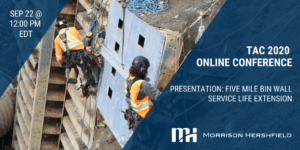 Five Mile Bin Wall Service Life Extension – Tuesday, Sept. 22 at 12:30 pm EST – Room Webinar #1
Five Mile Bin Wall Service Life Extension – Tuesday, Sept. 22 at 12:30 pm EST – Room Webinar #1 8 Considerations for Prioritizing Transportation Projects and Maximizing Operating Expenses – Thursday, Sept. 24 at 2:00 pm EST – Room Webinar #1
8 Considerations for Prioritizing Transportation Projects and Maximizing Operating Expenses – Thursday, Sept. 24 at 2:00 pm EST – Room Webinar #1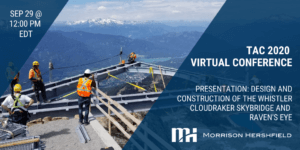 Design and Construction of the Whistler Cloudraker Skybridge and Raven’s Eye – Tuesday, Sept. 29 at 12:00 pm – Room Webinar #1
Design and Construction of the Whistler Cloudraker Skybridge and Raven’s Eye – Tuesday, Sept. 29 at 12:00 pm – Room Webinar #1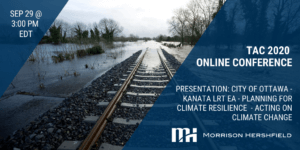 Kanata LRT EA – Planning for Climate Resilience – Tuesday, Sept. 29 at 3:00 pm – Room Webinar #2
Kanata LRT EA – Planning for Climate Resilience – Tuesday, Sept. 29 at 3:00 pm – Room Webinar #2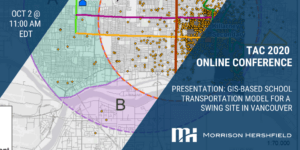 GIS-Based School Transportation Model for Swing Site – Friday, Oct. 2 at 11:00 am – Room Webinar #2
GIS-Based School Transportation Model for Swing Site – Friday, Oct. 2 at 11:00 am – Room Webinar #2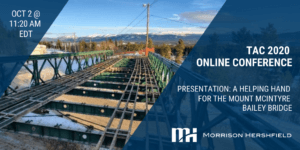 A Helping Hand for the Mount McIntyre Bailey Bridge – Friday, Oct. 2 at 11:20 am – Room Webinar #3
A Helping Hand for the Mount McIntyre Bailey Bridge – Friday, Oct. 2 at 11:20 am – Room Webinar #3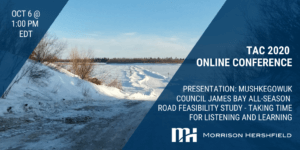 Mushkegowuk Council James Bay All-Season Road Feasibility Study – Taking Time for Listening and Learning – Tuesday, Oct. 6 at 1:00 pm – Room Webinar #3
Mushkegowuk Council James Bay All-Season Road Feasibility Study – Taking Time for Listening and Learning – Tuesday, Oct. 6 at 1:00 pm – Room Webinar #3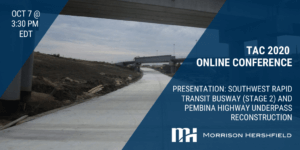 Southwest Rapid Transit Busway (Stage 2) and Pembina Highway Underpass Reconstruction – Wednesday, Oct. 7 at 3:30 pm – Room Webinar #1
Southwest Rapid Transit Busway (Stage 2) and Pembina Highway Underpass Reconstruction – Wednesday, Oct. 7 at 3:30 pm – Room Webinar #1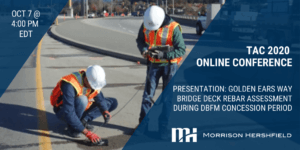 Presentation: Golden Ears Way Bridge Deck Rebar Assessment During DBFM Period – Wednesday, Oct. 7 at 4:00 pm – Room Webinar #3
Presentation: Golden Ears Way Bridge Deck Rebar Assessment During DBFM Period – Wednesday, Oct. 7 at 4:00 pm – Room Webinar #3